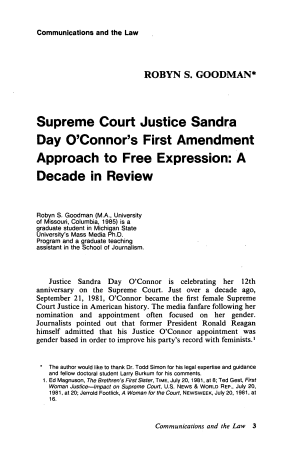Supreme Court Justice Sandra Day O'Connor's First Amendment Approach to Free Expression: A Decade in Review
December 1993

DISCLAIMER: This text has been transcribed automatically and may contain substantial inaccuracies due to the limitations of automatic transcription technology. This transcript is intended only to make the content of this document more easily discoverable and searchable. If you would like to quote the exact text of this document in any piece of work or research, please view the original using the link above and gather your quote directly from the source. The Sandra Day O'Connor Institute does not warrant, represent, or guarantee in any way that the text below is accurate.
Article Text
(Excerpt, Automatically generated)
Communications and the Law
ROBYN S. GOODMAN*
Supreme Court Justice Sandra Day O'Connor's First Amendment Approach to Free Expression: A Decade in Review
Robyn S. Goodman (M.A., University of Missouri, Columbia, 1985) is a graduate student in Michigan State University's Mass Media Ph.D. Program and a graduate teaching assistant in the School of Journalism.
Justice Sandra Day O'Connor is celebrating her 12th anniversary on the Supreme Court. Just over a decade ago, September 21, 1981, O'Connor became the first female Supreme Court Justice in American history. The media fanfare following her nomination and appointment often focused on her gender. Journalists pointed out that former President Ronald Reagan himself admitted that his Justice O'Connor appointment was gender based in order to improve his party's record with feminists. 1
The author would like to thank Dr. Todd Simon for his legal expertise and guidance and fellow doctoral student Larry Burkum for his comments.
Ed Magnuson, The Brethren's First Sister, TIME, July 20, 1981, at 8; Ted Gest, First Woman Justice-Impact on Supreme Court, U.S. NEWS & WORLD REP., July 20, 1981, at 20; Jerrold Footlick, A Woman for the Court, NEWSWEEK, July 20, 1981, at 16.
In addition, journalistic coverage often focused on how a female perspective might influence a predominantly white, male Court.2
Two authors, Heck and Arledge, have studied Justice O'Connor's opinions during her first few terms as a Supreme Court Justice and claim that
